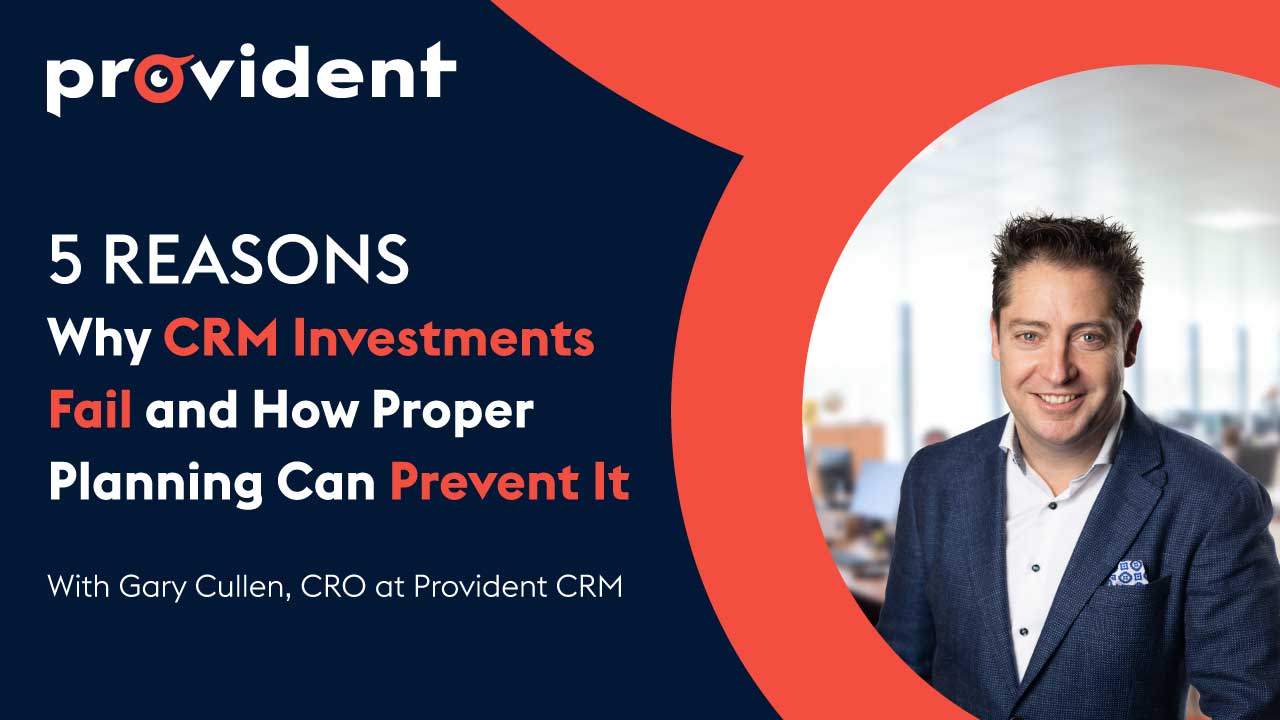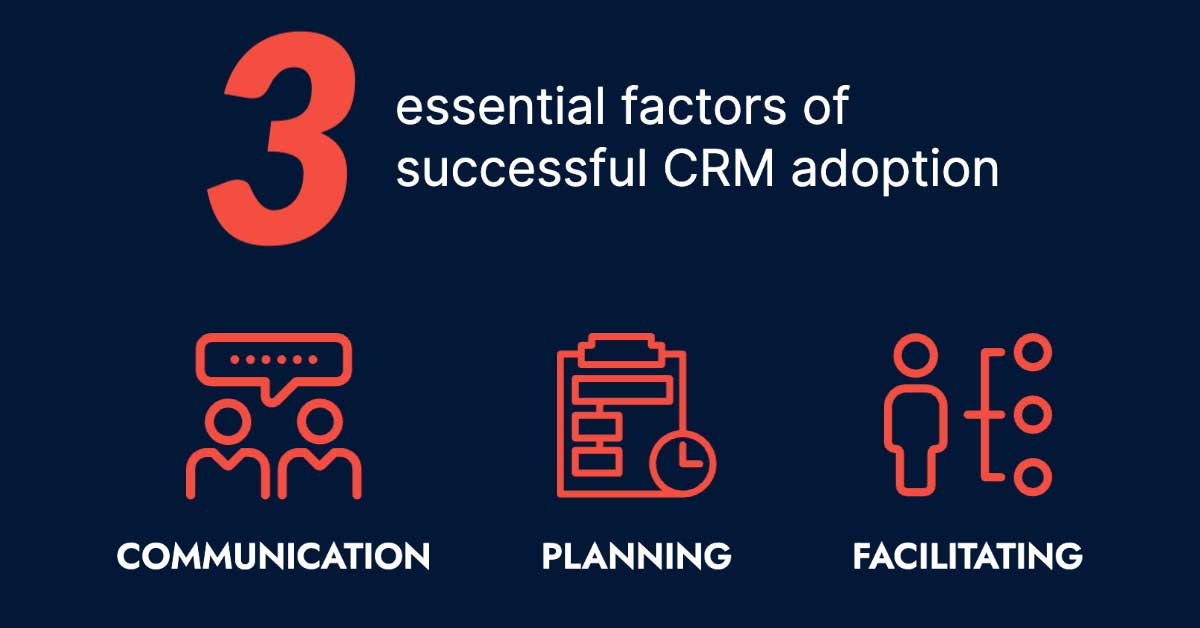
Implementing a CRM system is a significant commitment and expense for any company — one that’s well worth the investment, when done properly. Over my time with Provident CRM, my most satisfying projects have been helping clients whose previous CRM experiences have left them out of pocket and underwhelmed, enabling them to harness the transformative business potential of CRM done right.
Here, I share my thoughts on identifying and steering clear of failed CRM investment, to help you design and spend right the first time.
Ultimately, the users, flagbearers and financers of the CRM implementation within your organisation will be frustrated with the results. The CRM isn’t living up to expectations, usually across these principal factors:
Your CRM isn’t providing your teams with the data they need for strategic business evolution. Nor is it providing useful insights on the relative success or failure of specific campaigns or strategies across your business ecosystem, from marketing to finance. In short, your CRM isn’t built for the reporting, tracking and evaluation needed to move your business forward.
Employees engaging with your CRM are complaining that it’s unintuitive, complex and doesn’t meet their needs. Using the system is a hassle, taking up more of their time than it should and giving nothing back.
Your employees haven’t been given the opportunity to grasp and take ownership of the value they’ll gain from engaging with your CRM system. As a result, they’re (understandably) hesitant to dedicate time to exploring it and integrating it into their workload. Often, this failure arises due to a top-down approach to CRM implementation, missing the opportunity to generate employee buy-in and motivation at the system design stage.
Given the alignment between successful CRM implementation and a company’s unique business objectives and roll-out planning, there are as many definitions of CRM success as there are businesses out there. However, I’d highlight these main reasons for failure:
Are there processes that exist in your organisation simply because someone, at some point, decided things should be done that way and no one’s challenged the thinking since? That new employees might briefly raise an eyebrow at because they seem fairly nonsensical? If so, you’re by no means alone. This status quo mindset is a common killer of CRM systems. It means that, instead of leveraging the capabilities of the new system to facilitate and evolve your ways of working, your CRM simply becomes an iteration of the limits you were previously working within. New look, same efficiency-blocking feel.
To avoid this, it’s vital to shift your focus away from the “done thing” within your organisation when implementing your CRM. Your new north star should be the outcomes and customer journey you want to create, uprooting ingrained underperforming processes to start afresh. It takes bravery to speak out against the accepted way of doing things, yes, but it’s the only way to ensure your CRM elevates your existing processes and business performance.
Often, teams working in silos create challenges for other teams, without even knowing it. Redefining the process must bring these teams together to ensure a smooth and timely transition. An example could be where the sales team has to get a legal document signed as part of their process. The legal team are very happy with the document as it protects the business, but the sales team struggle to get it accepted by prospects as it’s too one-sided, so it delays or prevents closing sales opportunities. The business only measures the average time taken to close opportunities or the close rate, not the level of changes requested in the legal document.
It’s vital to shift focus away from the “done thing” when implementing your CRM. Your new north star should be the outcomes and customer journey you want to create.”
– Gary Cullen, CRO at Provident CRM
A lack of clarity on how the right CRM system can transform how you do business, end to end, often leads companies to view a CRM project as a mere moment in time. This creates shaky CRM foundations and just about ensures that the return on your CRM investment will be short-lived: how can it serve your business interests, both now and in the future, if it’s not built with your roadmap in mind?
For long-term success, CRM projects should be thought of as continuous evolutions. Revisited every month as a standard feature of management, executive and employee check-ins, with the mindset that — in a world that changes at lightning speed — software that can rapidly adapt as your business pivots is an invaluable asset.
Minor monthly or quarterly course corrections or changes allow the system to evolve with you and avoid it becoming a three or five-year recurring project that absorbs considerable time and creates disruption. A CRM project shouldn’t be focused on ending at the Go Live date; it should continue on as a part of executive leadership driving continual process improvement.
We’ve all been there: a bright idea is suggested but doesn’t make it to executive-level approval. No one with enough authority to effect change champions the project, so it fails to generate interest and eventually gets shelved.
For CRM success, executive sponsorship is key. This paves the way for widespread adoption, as a senior figure confirms that the implementation is strategically key for business objectives. To move with the times and perform at their best, employees need to be on board. Weaving CRM success into the future vision of the business can only be actioned by senior leadership, driving its importance and truly believing in the benefits of the success of the initiative.
Despite its importance, top-down buy-in alone isn’t enough to ensure CRM success. A lack of change management ends in low employee adoption of the new system, sealing its fate as an ill-planned investment. Turning the new software on is the easy part; the tricky element is guiding each of your employees through the CRM implementation journey and communicating the tangible benefits it will bring them.
For your CRM to succeed, your employees need to gain true ownership of the system, rather than feeling like it’s simply a way for management to keep a closer eye on their performance. The handy thing is that bottom-up buy-in tends to spread quickly, once one of your teams experiences the transformational change the right CRM enables. This creates a symbiosis with gaining wider executive buy-in needed for CRM success: once news of the system’s success and potential reaches executive ears, it’s often not long before it finds leadership-level enthusiasm.

While cloud-based solutions have relieved technology alignment issues to a large extent, it’s still key to leverage your company’s existing technology decisions, rather than trying to implement a solution that’s at odds with them.
If your CRM roll-out plans immediately run into scepticism or resistance from your company’s technical brains, this can be tough to counteract. Their buy-in is crucial to ensure your deployment runs at its best, integrating with any legacy systems that are vital to your business. Ensure your technical team gains the required knowledge and certifications to become product experts and adopt the management of the new system.
Building a CRM system that elevates the valuable essence of your existing workflows requires a 360° view. Involving all your business units in designing your CRM is key: how and why do they do what they do, how does it (intend to) benefit your company and how do their workflows impact other business areas?
As well as catering to all departments within your CRM design process, it’s vital to ensure all your employees feel heard and included — regardless of their level of enthusiasm for the new system. Some will voice resistance, instinctively preferring to stick to what they know. Employees who already recognise the potential of the system to resolve their pain points, however, may need reining in before they get carried away with the implementation scope! In the middle, you’ll find the majority who’ll determine whether the implementation is a success or failure: willing to come along, so long as the new system helps them get their work done well and efficiently.
To address these groups’ needs, your stakeholder strategy needs to be multifaceted: intelligently easing the hesitators in, managing the pioneer enthusiasts’ pace and communicating the CRM’s tangible benefits for the majority (automated efficiency, lighter workloads, better customer understanding, increased sales, and so on).
Any worthwhile improvement to your internal processes is ultimately done with your end customer in mind. With CRM design, this means considering what your buyers need from each touchpoint that’s integrated into your CRM, rather than simply what your internal teams need. This enables you to craft the personalised consumer experience customers expect from their B2B interactions.
Stay selective with the customer data you collect, too. A less is more approach enhances both your internal efficiency and your client relationships. Your employees only need to spend time filling in value-adding fields, eliminating time-wasting hassle and priming your CRM to give them valuable insights back. Your clients, meanwhile, experience the bespoke service you can craft through strategic, responsible data gathering.
At Provident CRM, we know we’ve reached CRM success when a client comes to us on Go Live day and says “We want more!”
We combine years of cross-sector expertise with the knowledge that there’s no one-size-fits-all in CRM. A company’s system needs to synergise with the methodologies that have already brought it success, enhancing and evolving its differentiators for future-ready growth.
We’re able to bring fresh eyes to an organisation, identifying blind spots and unafraid to ask the tricky questions when needed. Ultimately, we work based on trust. Our clients’ success is our success and we’re committed to enabling them to extract maximum value from their CRM as it becomes a core, evolving element of their business.